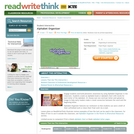
Students use this online tool to create an alphabet chart or pages for an alphabet book.
- Subject:
- Arts and Humanities
- Material Type:
- Activity/Lab
- Interactive
- Provider:
- ReadWriteThink
- Provider Set:
- ReadWriteThink
- Date Added:
- 08/19/2013

Students use this online tool to create an alphabet chart or pages for an alphabet book.
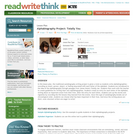
The traditional autobiography writing project is given a twist as students write alphabiographies - recording an event, person, object, or feeling associated with each letter of the alphabet.

An interactive applet and associated web page that demonstrate the alternate exterior angles that are formed where a transversal crosses two lines. The applets shows the two possible pairs of angles alternating when in animation mode. By dragging the three lines, it can be seen that the angles are congruent only when the lines are parallel. When not in animated mode, there is a button that alternates the two pairs of angles. The text on the page discusses the properties of the angle pairs both in the parallel and non-parallel cases. Applet can be enlarged to full screen size for use with a classroom projector. This resource is a component of the Math Open Reference Interactive Geometry textbook project at http://www.mathopenref.com.

An interactive applet and associated web page that demonstrate the alternate interior angles that are formed where a transversal crosses two lines. The applets shows the two possible pairs of angles alternating when in animation mode. By dragging the three lines, it can be seen that the angles are congruent only when the lines are parallel. When not in animated mode, there is a button that alternates the two pairs of angles. The text on the page discusses the properties of the angle pairs both in the parallel and non-parallel cases. Applet can be enlarged to full screen size for use with a classroom projector. This resource is a component of the Math Open Reference Interactive Geometry textbook project at http://www.mathopenref.com.
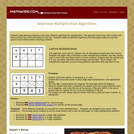
Students today develop proficiency with many different algorithms for multiplication. This approach insures that each student will find a method that works effectively for him/her. Teachers model the different algorithms and encourage students to use and practice each method before selecting a favorite.
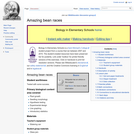
Developed for fifth grade and above. Primary biological content area covered:; Plant growth; Seedling morphology; Hypothesis testing; Experimental design; Line graphing; Introductory statistics.Biology In Elementary Schools is a Saint Michael's College student project. The teaching ideas on this page have been found, refined, and developed by students in a college-level course on the teaching of biology at the elementary level. Unless otherwise noted, the lesson plans have been tried at least once by students from our partner schools. This wiki has been established to share ideas about teaching biology in elementary schools. The motivation behind the creation of this page is twofold: 1. to provide an outlet for the teaching ideas of a group of college educators participating in a workshop-style course; 2. to provide a space where anyone else interested in this topic can place their ideas.
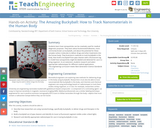
Students learn how nanoparticles can be creatively used for medical diagnostic purposes. They learn about buckminsterfullerenes, more commonly known as buckyballs, and about the potential for these complex carbon molecules to deliver drugs and other treatments into the human body. They brainstorm methods to track buckyballs in the body, then build a buckyball from pipe cleaners with a fluorescent tag to model how nanoparticles might be labeled and detected for use in a living organism. As an extension, students research and select appropriate radioisotopes for different medical applications.

Students design, build and test model roller coasters using foam tubing. The design process integrates energy concepts as they test and evaluate designs that address the task as an engineer would. The goal is for students to understand the basics of engineering design associated with kinetic and potential energy to build an optimal roller coaster. The marble starts with potential energy that is converted to kinetic energy as it moves along the track. The diameter of the loops that the marble traverses without falling out depends on the kinetic energy obtained by the marble.

This lesson unit is intended to help teachers assess how well students are able to: work with concepts of congruency and similarity, including identifying corresponding sides and corresponding angles within and between triangles; Identify and understand the significance of a counter-example; Prove, and evaluate proofs in a geometric context.

Students are often asked to perform speeches, but rarely do we require students to analyze speeches as carefully as we study works of literature. In this unit, students are required to identify the rhetorical strategies in a famous speech and the specific purpose for each chosen device. They will write an essay about its effectiveness and why it is still famous after all these years.
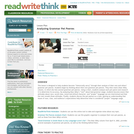
By analyzing Dear Abby's rant about bad grammar usage, students become aware that attitudes about race, social class, moral and ethical character, and "proper" language use are intertwined.
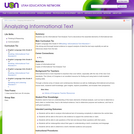
In this lesson students use the Informational Text Analysis Tool to deconstruct the essential elements of informational text. Informational text is more important to teachers than ever before, especially with the rise of the new Core standards. The Library of Congress is an excellent resource for finding and using texts to build students' reading skills.Through a diverse array of classic and contemporary literature as well as challenging informational and primary source texts, students build knowledge, gain insights, explore possibilities, and broaden their perspective.
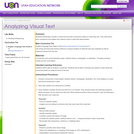
In this lesson Students individually consider a visual text and draw conclusions based on what they see. They write about their conclusions and explain the evidence used to make that determination. Students will be able to analyze a visual text. Students will be able to develop and support a claim about the visual text based on evidence found in the text.
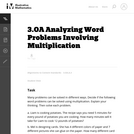
In this task, the students are not asked to find an answer, but are asked to analyze word problems and explain their thinking. In the process, they are faced with varying ways of thinking about multiplication.

Students analyze images of Oscar Wilde used to publicize his 1882 American lecture tour. They then compare a caricature to another researched image, sharing this analysis in a podcast.
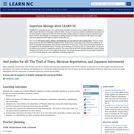
Many textbooks mention the Trail of Tears, but fail to mention that this early displacement of an ethnic minority is only the one of many legally-sanctioned forced relocations. This lesson will address the displacement of American Indians through the Trail of Tears, the forced deportation of Mexican Americans during the Great Depression, and the internment of Japanese American citizens during WWII.
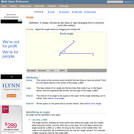
An interactive applet and associated web page that introduce the concept of an angle. An angle made from two line segments is shown that the user can adjust by dragging the end points of the segments. In real time, as the angles is changed by the user, the angle measure in degrees is shown and a message telling what type of angle it currently is: acute, right, obtuse, reflex or straight. Applet can be enlarged to full screen size for use with a classroom projector. This resource is a component of the Math Open Reference Interactive Geometry textbook project at http://www.mathopenref.com.
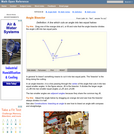
An interactive applet and associated web page that demonstrate the bisector of an angle. An angle is shown using two line segments that can be dragged to change the angle measure. The angle is bisected by a line which moves while dragging to always divide the angle into two equal angles. The angle measures can be turned off for class discussions. Applet can be enlarged to full screen size for use with a classroom projector. This resource is a component of the Math Open Reference Interactive Geometry textbook project at http://www.mathopenref.com.
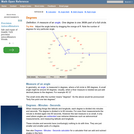
An interactive applet that acts as a 'digital manipulative' for explaining angles measured in degrees. The applet has an angle formed from two segment that can be dragged around in a circle. The angle measure is shown against a 'clock face' calibrated in degrees. The measures can be turned off for class angle estimation discussions. Applet can be enlarged to full screen size for use with a classroom projector. This resource is a component of the Math Open Reference Interactive Geometry textbook project at http://www.mathopenref.com.
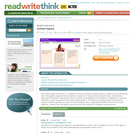
Supporting inquiry-based research projects, the Animal Inquiry interactive invites elementary students to explore animal facts and habitats using writing prompts to guide and record their findings.